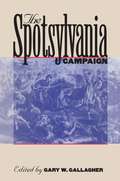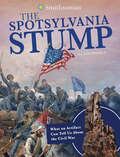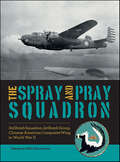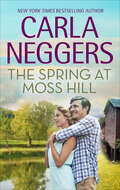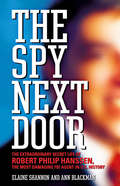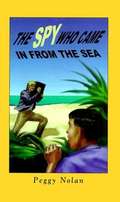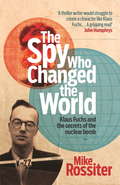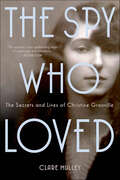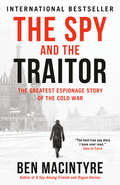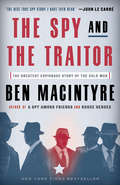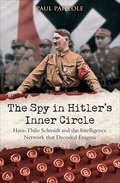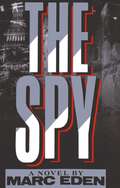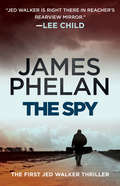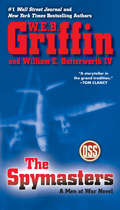- Table View
- List View
The Spotsylvania Campaign
by Gary W. GallagherThe Spotsylvania Campaign was a crucial period in the protracted confrontation between Ulysses S. Grant and Robert E. Lee in spring 1864. Approaching the campaign from a variety of perspectives, the contributors to this volume explore questions regarding high command, tactics and strategy, the impact of continuous fighting on officers and soldiers in both armies, and the ways in which some participants chose to remember and interpret the campaign. They offer insight into the decisions and behavior of Lee and of Federal army leaders, the fullest descriptions to date of the horrific fighting at the "Bloody Angle" on May 12, and a revealing look at how Grant used his memoirs to counter Lost Cause interpretations of his actions at Spotsylvania and elsewhere in the Overland Campaign.The contributors are William A. Blair, Peter S. Carmichael, Gary W. Gallagher, Robert E. L. Krick, Robert K. Krick, William D. Matter, Carol Reardon, and Gordon C. Rhea.
The Spotsylvania Stump: What an Artifact Can Tell Us About the Civil War (Artifacts from the American Past)
by John Micklos Jr.The bloody Battle of Spotsylvania Court House took place in May 1864. The frantic back-and-forth fighting at an area now called the Bloody Angle was among the fiercest single-day battles of the entire Civil War. How did the bullet-riddled stump of a once-mighty oak tree there become a symbol of the conflict? What can its story tell us about that day’s battle and the broader history of the Civil War? Readers will out the answers to these questions and discover more of what the Spotsylvania Stump can tell us about history.
The Spray and Pray Squadron: 3rd Bomb Squadron, 1st Bomb Group, Chinese-American Composite Wing in World War II
by Margaret Mills KincannonThe Chinese-American Composite Wing combined Chinese and American pilots, crew, and ground personnel into integrated squadrons
The Spread Of Nuclear Weapons: An Enduring Debate (Third Edition)
by Kenneth N. Waltz Scott Douglas SaganOver the past fifteen years, The Spread of Nuclear Weapons has been a staple in International Relations courses because of its brevity and crystal-clear explanations. The new edition, An Enduring Debate, continues the important discussion of nuclear proliferation and the dangers of a nuclear-armed world. With new chapters on the questions surrounding a nuclear North Korea, Iran, and Iraq and the potential for a world free of nuclear weapons, this Third Edition will continue to generate a lively classroom experience.
The Spring at Moss Hill: A Knights Bridge Christmas The Spring At Moss Hill Red Clover Inn The River House (The Swift River Valley Novels #6)
by Carla NeggersA children’s book illustrator learns to open up when a chance at love enters the picture in this New England romance.Children’s book illustrator Kylie Shaw has found a home in quiet, little Knights Bridge, Massachusetts. No one seems to know her here—and that’s how she likes it. She carefully guards her privacy from her loft in a refurbished nineteenth-century hat factory. And then California private investigator Russ Colton moves in.Russ is in Knights Bridge to keep his client, eccentric Hollywood costume designer Daphne Stewart, out of trouble. Keeping tabs on Daphne while she considers starting a children’s theater is a simple job—until Kylie opposes the idea of a theater opening in her building. Now Russ wonders how he can get this buttoned up beauty to let loose a little . . . like the adventurous characters in her books . . .
The Spring of Kasper Meier: ‘Beguiling, unsettling, and wonderfully atmospheric' (Sarah Waters)
by Ben FergussonFergusson has already won two awards for this gripping and atmospheric debut, a thriller set amid the rubble of a defeated Berlin in 1945...Original and highly accomplished' Sunday TimesShortlisted for the Sunday Times Young Writer of the Year Award 2015Berlin, 1946. Everything is in short supply. Including the truth.The war is over, but Berlin is a desolate sea of rubble. There is a shortage of everything: food, clothing, tobacco. The local population is scrabbling to get by. Kasper Meier is one of these Germans, and his solution is to trade on the black market to feed himself and his elderly father. He can find anything that people need, for the right price. When a young woman, Eva, arrives at Kasper's door seeking the whereabouts of a British pilot, he feels a reluctant sympathy for her but won't interfere in military affairs. But Eva knows Kasper has secrets, and she'll use them to get what she wants. As a net of deceit, lies and betrayal falls around him, Kasper begins to understand that the seemingly random killings of members of the occupying forces are connected to his own situation. He must work out who is behind Eva's demands, and why...A gripping literary thriller that will captivate fans of Joseph Kanon and Hans Fallada. Readers are saying:'A remarkable, dark, deep and disturbing novel''Brilliantly realised both in the evocation of Berlin and in the story line. Both poignant and thrilling''What an amazing book - I was engrossed''A terrific novel. Thoughtful, powerful writing serving an original and compelling plot''Utterly enthralling'
The Spring of Kasper Meier: ‘Beguiling, unsettling, and wonderfully atmospheric' (Sarah Waters)
by Ben FergussonFergusson has already won two awards for this gripping and atmospheric debut, a thriller set amid the rubble of a defeated Berlin in 1945...Original and highly accomplished' Sunday TimesShortlisted for the Sunday Times Young Writer of the Year Award 2015Berlin, 1946. Everything is in short supply. Including the truth.The war is over, but Berlin is a desolate sea of rubble. There is a shortage of everything: food, clothing, tobacco. The local population is scrabbling to get by. Kasper Meier is one of these Germans, and his solution is to trade on the black market to feed himself and his elderly father. He can find anything that people need, for the right price. When a young woman, Eva, arrives at Kasper's door seeking the whereabouts of a British pilot, he feels a reluctant sympathy for her but won't interfere in military affairs. But Eva knows Kasper has secrets, and she'll use them to get what she wants. As a net of deceit, lies and betrayal falls around him, Kasper begins to understand that the seemingly random killings of members of the occupying forces are connected to his own situation. He must work out who is behind Eva's demands, and why...A gripping literary thriller that will captivate fans of Joseph Kanon and Hans Fallada. Readers are saying:'A remarkable, dark, deep and disturbing novel''Brilliantly realised both in the evocation of Berlin and in the story line. Both poignant and thrilling''What an amazing book - I was engrossed''A terrific novel. Thoughtful, powerful writing serving an original and compelling plot''Utterly enthralling'
The Spring of Kasper Meier: ‘Beguiling, unsettling, and wonderfully atmospheric’ (Sarah Waters)
by Ben FergussonThe war is over, but Berlin is a desolate sea of rubble. There is a shortage of everything: food, clothing, tobacco. The local population is scrabbling to get by. Kasper Meier is one of these Germans, and his solution is to trade on the black market to feed himself and his elderly father. He can find anything that people need, for the right price. Even other people.When a young woman, Eva, arrives at Kasper's door seeking the whereabouts of a British pilot, he feels a reluctant sympathy for her but won't interfere in military affairs. But Eva is prepared for this. Kasper has secrets, she knows them, and she'll use them to get what she wants. As the threats against him mount, Kasper is drawn into a world of intrigue he could never have anticipated. Why is Eva so insistent that he find the pilot? Who is the shadowy Frau Beckmann and what is her hold over Eva? Under constant surveillance, Kasper navigates the dangerous streets and secrets of a city still reeling from the horrors of war and defeat. As a net of deceit, lies and betrayal falls around him, Kasper begins to understand that the seemingly random killings of members of the occupying forces are connected to his own situation. He must work out who is behind Eva's demands, and why - while at the same time trying to save himself, his father and Eva.
The Spy Masters Thrillers
by Alex GerlisJourney behind enemy lines in Second World War Europe with the The Spy Masters Thrillers. Includes all four books in the series; The Best of Our Spies, The Swiss Spy, Vienna Spies and The Berlin Spies.The Best of Our Spies: In the Pas de Calais, Nathalie Mercier, a young British Special Operations Executive secret agent working with the French Resistance, disappears. In London, her husband Owen Quinn, an officer with Royal Navy Intelligence, discovers the truth about her role in the Allies’ sophisticated deception at the heart of D-Day. Appalled but determined, Quinn sets off on a perilous hunt through France in search of his wife. Aided by the Resistance in his search, he makes good progress. But, caught up by the bitterness of the war and its insatiable appetite for revenge, he risks total destruction…The Swiss Spy: All spies have secrets, but Henry Hunter has more than most. After he is stopped by British Intelligence at Croydon airport on the eve of the Second World War, he discovers one more devastating than any before. From Switzerland he embarks on a series of increasingly perilous missions into Nazi Germany. In March, 1941, in Berlin, haunted by a dark episode from his past, he makes a fateful decision, resulting in a dramatic journey to the Swiss frontier and a shocking encounter…Vienna Spies: With the end of the Second World War in sight, the Allies begin to divide up the spoils and it proves to be a dangerous game. The British have become aware that, contrary to prior agreements, the Soviet Union is intent on controlling Austria once the war ends. Major Edgar is tasked with the job of establishing an espionage unit in Vienna to monitor the situation. He sends in two agents – Rolf Eder and Katharina Hoch – to track down Austria's most respected politician and bring him over to the British cause. But the feared Soviet spy Viktor Krasotkin is already in the war-torn city, embarking on exactly the same mission…The Berlin Spies: Berlin, 1945. SS recruits gather east of the city for an audacious yet ill-fated mission to bring about a Fourth Reich. Three decades later, a young British diplomat in East Berlin is compromised after falling into a honey-trap. He contacts Major Edgar, a veteran British spymaster, who is drawn into an unlikely alliance with his old adversary, Viktor Krasotkin. Soon they are plunged into a world of Nazi war criminals and double agents. With nobody to trust, they must rely on each other. But as Cold War tensions rise, the cracks begin to show.A masterclass in espionage fiction, these tense, tightly plotted novels are perfect for fans of John le Carré, Len Deighton and Jack Higgins.Praise for Alex Gerlis‘A classic spy story, with twists and turns that keep you engrossed. Excellent.’ ***** Reader review‘Brilliant… you cannot put it down. Spy thriller lovers must read this incredible story.’ ***** Reader review‘The sense of time and place is second to none, and the characters are well drawn and very believable. A hugely satisfying and entertaining venture into the spy fiction genre.’ ***** Reader review‘I couldn't put this down it grabbed my attention so well. Great attention to detail – like the Phillip Kerr or John Le Carre novels.’ ***** Reader review‘Gerlis is always a superb read. He never fails to deliver a well researched spellbinder.’ ***** Reader review
The Spy Next Door: The Extraordinary Secret Life of Robert Philip Hanssen, The Most Damaging FBI Agent In U.S. History
by Elaine Shannon Ann BlackmanA shocking, fascinating account of one of the greatest espionage scandals of our time. Ann Blackman and Elaine Shannon reveal the truth about Robert Hanssen and his 15 years of exceptionally destructive espionage. They brilliantly explore why Hanssen decided to betray his family, his church and his country, and how he got away with it.
The Spy Who Came In from the Sea
by Peggy NolanFourteen-year old Frank Hollahan moves to Florida in 1943, at the height of World War II, to join his father, a Navy seaman. When Frank and his mother arrive at the busy naval port of Jacksonville, a surprising new life awaits them. In his new school, Frank's tendency toward exaggeration quickly builds him a reputation as a teller of tales. When he informs everyone that he saw an enemy spy land on the local beach, no one believes him, but Frank sets out to prove the spy's existence. The spy who came in from the sea ends up teaching Frank and the people of Jacksonville valuable lessons about friendship, perseverance, and the power of the truth.
The Spy Who Changed The World
by Mike RossiterThe world first heard of Klaus Fuchs, the head of theoretical physics at the British Research Establishment at Harwell in February 1950 when he appeared at the Old Bailey, accused of passing secrets to the Soviet Union. For over sixty years disinformation and lies surrounded the story of Klaus Fuchs as the Governments of Britain, the United States and Russia all tried to cover up the truth about his treachery.Piecing together the story from archives in Britain, the United States, Russia and Germany, The Spy Who Changed the World unravels the truth about Fuchs and reveals for the first time his long career of espionage. It proves that he played a pivotal role in Britain's bomb programme in the race to keep up with the United States in the atomic age, and that he revealed vital secrets about the atom bomb, as well as the immensely destructive hydrogen bomb to the Soviet Government. It is a dramatic tale of clandestine meetings, deadly secrets, family entanglements and illicit love affairs, all set against the tumultuous years from the rise of Hitler to the start of the Cold War.
The Spy Who Changed The World
by Mike RossiterThe world first heard of Klaus Fuchs, the head of theoretical physics at the British Research Establishment at Harwell in February 1950 when he appeared at the Old Bailey, accused of passing secrets to the Soviet Union. For over sixty years disinformation and lies surrounded the story of Klaus Fuchs as the Governments of Britain, the United States and Russia all tried to cover up the truth about his treachery.Piecing together the story from archives in Britain, the United States, Russia and Germany, The Spy Who Changed the World unravels the truth about Fuchs and reveals for the first time his long career of espionage. It proves that he played a pivotal role in Britain's bomb programme in the race to keep up with the United States in the atomic age, and that he revealed vital secrets about the atom bomb, as well as the immensely destructive hydrogen bomb to the Soviet Government. It is a dramatic tale of clandestine meetings, deadly secrets, family entanglements and illicit love affairs, all set against the tumultuous years from the rise of Hitler to the start of the Cold War.
The Spy Who Loved Us
by Thomas A. BassPham Xuan An was a brilliant journalist and an even better spy. A friend to all the legendary reporters who covered the Vietnam War, he was an invaluable source of news and a font of wisdom on all things Vietnamese. At the same time, he was a masterful double agent. An inspired shape-shifter who kept his cover in place until the day he died, Pham Xuan An ranks as one of the preeminent spies of the twentieth century. When Thomas A. Bass set out to write the story of An's remarkable career for The New Yorker, fresh revelations arrived daily during their freewheeling conversations, which began in 1992. But a good spy is always at work, and it was not until An's death in 2006 that Bass was able to lift the veil from his carefully guarded story to offer up this fascinating portrait of a hidden life. A masterful history that reads like a John le Carré thriller, The Spy Who Loved Us offers a vivid portrait of journalists and spies at war.
The Spy Who Loved Us
by Thomas A. BassPham Xuan An was a brilliant journalist and an even better spy. A friend to all the legendary reporters who covered the Vietnam War, he was an invaluable source of news and a font of wisdom on all things Vietnamese. At the same time, he was a masterful double agent. An inspired shape-shifter who kept his cover in place until the day he died, Pham Xuan An ranks as one of the preeminent spies of the twentieth century.When Thomas A. Bass set out to write the story of An's remarkable career for The New Yorker, fresh revelations arrived daily during their freewheeling conversations, which began in 1992. But a good spy is always at work, and it was not until An's death in 2006 that Bass was able to lift the veil from his carefully guarded story to offer up this fascinating portrait of a hidden life.A masterful history that reads like a John le Carré thriller, The Spy Who Loved Us offers a vivid portrait of journalists and spies at war.
The Spy Who Loved Us: The Vietnam War and Pham Xuan An's Dangerous Game
by Thomas A. BassPham Xuan An was a brilliant journalist and an even better spy. A friend to all the legendary reporters who covered the Vietnam War, he was an invaluable source of news and a font of wisdom on all things Vietnamese. At the same time, he was a masterful double agent. An inspired shape-shifter who kept his cover in place until the day he died, Pham Xuan An ranks as one of the preeminent spies of the twentieth century. When Thomas A. Bass set out to write the story of An's remarkable career for The New Yorker, fresh revelations arrived daily during their freewheeling conversations, which began in 1992. But a good spy is always at work, and it was not until An's death in 2006 that Bass was able to lift the veil from his carefully guarded story to offer up this fascinating portrait of a hidden life. A masterful history that reads like a John le Carré thriller, The Spy Who Loved Us offers a vivid portrait of journalists and spies at war.
The Spy Who Loved: The Secrets and Lives of Christine Granville
by Clare MulleyThe Spy Who Loved presents the untold story of Britain's first female Special Agent of World War II.In June 1952, a woman was murdered by an obsessed colleague in a hotel in the South Kensington district of London. Her name was Christine Granville. That she died young was perhaps unsurprising; that she had survived the Second World War was remarkable.The daughter of a feckless Polish aristocrat and his wealthy Jewish wife, Granville would become one of Britain's most daring and highly decorated special agents. Having fled to Britain on the outbreak of war, she was recruited by the intelligence services and took on mission after mission. She skied over the hazardous High Tatras into occupied Poland, served in Egypt and North Africa, and was later parachuted behind enemy lines into France, where an agent's life expectancy was only six weeks. Her courage, quick wit, and determination won her release from arrest more than once, and saved the lives of several fellow officers—including one of her many lovers—just hours before their execution by the Gestapo. More importantly, the intelligence she gathered in her espionage was a significant contribution to the Allied war effort, and she was awarded the George Medal, the OBE, and the Croix de Guerre.Granville exercised a mesmeric power on those who knew her. In The Spy Who Loved, acclaimed biographer Clare Mulley tells the extraordinary history of this charismatic, difficult, fearless, and altogether extraordinary woman.
The Spy and the Traitor: The Greatest Espionage Story of the Cold War
by Ben MacintyreThe celebrated author of A Spy Among Friends and Rogue Heroes returns with his greatest spy story yet, a thrilling Cold War-era tale of Oleg Gordievsky, the Russian whose secret work helped hasten the collapse of the Soviet Union.If anyone could be considered a Russian counterpart to the infamous British double-agent Kim Philby, it was Oleg Gordievsky. The son of two KGB agents and the product of the best Soviet institutions, the savvy, sophisticated Gordievsky grew to see his nation's communism as both criminal and philistine. He took his first posting for Russian intelligence in 1968 and eventually became the Soviet Union's top man in London, but from 1973 on he was secretly working for MI6. For nearly a decade, as the Cold War reached its twilight, Gordievsky helped the West turn the tables on the KGB, exposing Russian spies and helping to foil countless intelligence plots, as the Soviet leadership grew increasingly paranoid at the United States's nuclear first-strike capabilities and brought the world closer to the brink of war. Desperate to keep the circle of trust close, MI6 never revealed Gordievsky's name to its counterparts in the CIA, which in turn grew obsessed with figuring out the identity of Britain's obviously top-level source. Their obsession ultimately doomed Gordievsky: the CIA officer assigned to identify him was none other than Aldrich Ames, the man who would become infamous for secretly spying for the Soviets. Unfolding the delicious three-way gamesmanship between America, Britain, and the Soviet Union, and culminating in the gripping cinematic beat-by-beat of Gordievsky's nail-biting escape from Moscow in 1985, Ben Macintyre's latest may be his best yet. Like the greatest novels of John le Carré, it brings readers deep into a world of treachery and betrayal, where the lines bleed between the personal and the professional, and one man's hatred of communism had the power to change the future of nations.
The Spy and the Traitor: The Greatest Espionage Story of the Cold War
by Ben MacintyreThe celebrated author of A Spy Among Friends and Rogue Heroes returns with his greatest spy story yet, a thrilling Cold War-era tale of Oleg Gordievsky, the Russian whose secret work helped hasten the collapse of the Soviet Union.If anyone could be considered a Russian counterpart to the infamous British double-agent Kim Philby, it was Oleg Gordievsky. The son of two KGB agents and the product of the best Soviet institutions, the savvy, sophisticated Gordievsky grew to see his nation's communism as both criminal and philistine. He took his first posting for Russian intelligence in 1968 and eventually became the Soviet Union's top man in London, but from 1973 on he was secretly working for MI6. For nearly a decade, as the Cold War reached its twilight, Gordievsky helped the West turn the tables on the KGB, exposing Russian spies and helping to foil countless intelligence plots, as the Soviet leadership grew increasingly paranoid at the United States's nuclear first-strike capabilities and brought the world closer to the brink of war. Desperate to keep the circle of trust close, MI6 never revealed Gordievsky's name to its counterparts in the CIA, which in turn grew obsessed with figuring out the identity of Britain's obviously top-level source. Their obsession ultimately doomed Gordievsky: the CIA officer assigned to identify him was none other than Aldrich Ames, the man who would become infamous for secretly spying for the Soviets. Unfolding the delicious three-way gamesmanship between America, Britain, and the Soviet Union, and culminating in the gripping cinematic beat-by-beat of Gordievsky's nail-biting escape from Moscow in 1985, Ben Macintyre's latest may be his best yet. Like the greatest novels of John le Carré, it brings readers deep into a world of treachery and betrayal, where the lines bleed between the personal and the professional, and one man's hatred of communism had the power to change the future of nations.
The Spy and the Traitor: The Greatest Espionage Story of the Cold War
by Ben MacintyreNEW YORK TIMES BESTSELLER • From the celebrated author of Operation Mincement and The Siege comes the thrilling Americans-era tale of Oleg Gordievsky, the Russian whose secret work helped hasten the end of the Cold War.&“The best true spy story I have ever read.&”—JOHN LE CARRÉNamed a Best Book of the Year by The Economist • Shortlisted for the Bailie Giffords Prize in NonfictionIf anyone could be considered a Russian counterpart to the infamous British double-agent Kim Philby, it was Oleg Gordievsky. The son of two KGB agents and the product of the best Soviet institutions, the savvy, sophisticated Gordievsky grew to see his nation&’s communism as both criminal and philistine.He took his first posting for Russian intelligence in 1968 and eventually became the Soviet Union&’s top man in London, but from 1973 on he was secretly working for MI6. For nearly a decade, as the Cold War reached its twilight, Gordievsky helped the West turn the tables on the KGB, exposing Russian spies and helping to foil countless intelligence plots, as the Soviet leadership grew increasingly paranoid at the United States&’s nuclear first-strike capabilities and brought the world closer to the brink of war. Desperate to keep the circle of trust close, MI6 never revealed Gordievsky&’s name to its counterparts in the CIA, which in turn grew obsessed with figuring out the identity of Britain&’s obviously top-level source. Their obsession ultimately doomed Gordievsky: the CIA officer assigned to identify him was none other than Aldrich Ames, the man who would become infamous for secretly spying for the Soviets. Unfolding the delicious three-way gamesmanship between America, Britain, and the Soviet Union, and culminating in the gripping cinematic beat-by-beat of Gordievsky&’s nail-biting escape from Moscow in 1985, Ben Macintyre has crafted an electrifying account of an international hero. Like the greatest novels of John le Carré, The Spy and the Traitor brings readers deep into a world of treachery and betrayal, where the lines bleed between the personal and the professional, and one man&’s hatred of communism had the power to change the future of nations.
The Spy in Hitler's Inner Circle: Hans-Thilo Schmidt and the Allied Intelligence Network that Decoded Germany's Enigma
by Paul PailloleThis thrilling account of WWII espionage by the former French secret service chief chronicles an Allied spy&’s actions in the German Cipher Office. A spy for the French Secret Service during World War II, Hans-Thilo Schmidt was embedded in the nerve center of the Third Reich. From deep within Hitler&’s most sensitive operations, Schmidt created an intelligence network between France, Poland, and England. In The Spy in Hitler&’s Inner Circle, France&’s former secret service chief, Paul Paillole, offers a revealing chronicle of how Schmidt helped the Allies infiltrate German agencies and crack their encryption system, the Enigma machine. Paillole details how Schmidt delivered intelligence to France right from the source of the German Cipher Office. Revealed here are the most secret aspects of the so-called war of numbers that led to Alan Turing&’s historic codebreaking achievement at Bletchley Park. From information about Germany&’s rearmament and the reoccupation of the Rhineland to fundamental technical intelligence about the Enigma machine, Schmidt&’s contributions were key to the Allied victory in the intelligence war.
The Spy: A Novel
by Marc EdenTime: World War IIPlace: England – the summer&’s heat wave, 1944Young widow and mother Valerie Sinclair is a candidate for British Naval Intelligence when she is handpicked for a treacherous assignment and personally approved by Winston Churchill because of the unique way her mind works. After a brutal training program and an elaborate scheme to hide her true identity, she will meet the challenge of her life on Operation GOLDILOCKS, an ultra-secret mission scheduled for launch behind German lines, into Occupied France. Transformed by surgery, and disguised as a French schoolgirl, the purpose of Valerie&’s mission will be to effectively transfer the secrets of the first Atomic Bomb from German labs, via German and British banking partners, for the postwar benefit of the London Financial District.To succeed she must avoid a faceless pursuer. Fitting his movements to hers like a hand to a glove, is The Spy, the eerie mysterious figure who haunts her dreams. Moving with relentless resolve, The Spy becomes an uncanny part of the weavings in this startling revelation of international intrigue.Based on the memoirs of the real life British espionage agent Valerie Sinclair, this is the story of a war for information that affects the national prosperity of England and the United States for years to come.
The Spy: The First Jed Walker Thriller (A\jed Walker Series Novel Ser. #1)
by James PhelanA sinister group - code-named Zodiac - has launched devastating global attacks. Twelve targets across the world, twelve code-named missions.Operating distinct sleeper cells, they are the ultimate terrorist organisation, watching and waiting for a precise attack to activate the next group. It is a frightening and deadly efficient way to stay one step ahead. And cause the most chaos.For ex-CIA operative Jed Walker, chaos is his profession. On the outer, burned by his former agency, he is determined to clear his name. Stopping Zodiac is the only way. Desperate to catch the killers and find the mastermind, he can't afford to lose the next lead, but that means that sometimes the terrorists have to win.Ultimately, it all comes down to Walker: he's the only one who can break the chain and put the group to sleep . . . permanently. It's exactly eighty-one hours until deadline.
The Spymaster's Lady: Spymaster 2 (Spymaster)
by Joanna BourneJoanna Bourne returns to the French Revolution, pairing espionage and burning romance to create an unforgettable love story. For fans of Stephanie Laurens, Elizabeth Hoyt and Poldark, this is a must-read. She's never met a man she couldn't deceive...until now.She's braved battlefields, played the worldly courtesan, the naive virgin, the refined British lady, even a Gypsy boy. But Annique Villiers, the elusive spy known as the Fox Cub, has finally met the one man she can't outwit...British spymaster Robert Grey must enter France and capture the brilliant, beautiful - and dangerous - Fox Cub and her secrets for England. When the two natural enemies are thrown into prison, they forge an uneasy alliance to break free. But their pact is temporary and betrayal seems inevitable. As the fates of nations hang in the balance, Grey and Annique fight the passion that flares between them - forbidden, impossible and completely irresistible...For more spellbinding Spymasters romance, look for the other titles by Joanna Bourne: The Forbidden Rose, My Lord and Spymaster, The Black Hawk and Rogue Spy.
The Spymasters (Men at War #7)
by William E. Butterworth W.E.B. Griffin#1 Wall Street Journal and New York Times bestselling author W.E.B. Griffin continues his gripping series featuring the legendary OSS--fighting a silent war of spies and assassins in the shadows of World War II. Summer 1943. Two of the Allies' most important plans for winning World War II are at grave risk--the coming D-Day invasion and the Manhattan Project's race to build the atomic bomb. OSS spy chief William "Wild Bill" Donovan turns to his top agent, Dick Canidy, and his team. They've certainly got their work cut out for them. In the weeks to come, they must fight not only the enemy in the field--and figure out how to sabotage Germany's new "aerial torpedo" rockets--but also the enemy within. Someone is feeding Manhattan Project secrets to the Soviets. And if the Soviets build their own atomic bomb, winning the war might only lead to another, even more terrible conflict... FIRST TIME IN PAPERBACK
